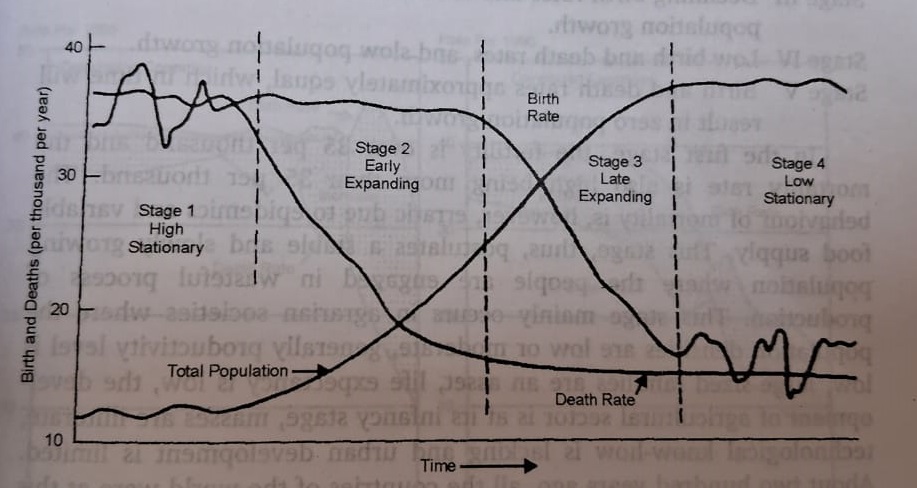The Demographic Transition Theory is a model that explains the transition of society from high birth and death rates to low birth and death rates as it undergoes economic and social development. This theory was first proposed by Warren Thompson in 1929 and later refined by Frank W. Notestein in the 20th century.
According to the Demographic Transition Theory, societies undergo four stages of demographic change.
- Stage 1: Pre-Industrial Stage
- Stage 2: Transitional Stage
- Stage 3: Industrial Stage
- Stage 4: Post-Industrial Stage

Table of Contents
Stage 1: Pre-Industrial Stage
This is the primitive stage. Here, both birth rates and death rates are high. It results in a stable or slowly growing population. Access to healthcare is limited, sanitation is poor, and the infant mortality rate is high. Families prefer to have many children to ensure social security and to compensate for high child mortality rates. Such trends are common in the pre-industrial societies.
"Despite high birth rates, population growth is slow due to the balancing effect of high death rates."

Stage 2: Transitional Stage
This stage occurs once industrialization starts. This leads to an increase in per capita income and improvements in healthcare, sanitation, and education. The death rates decline rapidly due to advancements in healthcare, birth rates remain high. This leads to rapid population growth as more individuals survive into adulthood.

Stage 3: Industrial Stage
In this stage, the birth rate starts declining. Factors behind the declining birth rate are increased urbanization, improved education, better access to contraception, and changes in social norms. Death rates continue to remain low. The declining birth rates result in a slowing down of population growth.

Stage 4: Post-Industrial Stage
In this stage, both birth and death rates are low. Birth rates stabilize at a level close to the replacement rate. The population growth is minimal or stagnant. The increased urbanization, higher education levels, widespread availability of contraceptives, and changes in family structure and values are evident.

There is yet another stage in Demographic Transition Theory, this is called a fifth stage. In this stage, the population starts declining due to the low fertility rate and the aging population. Some European Countries are examples of this type of demographic phase.
The Demographic Transition Theory has been widely used to understand and predict population changes in different regions of the world. However, it’s important to note that not all countries follow this transition linearly, and there are variations and exceptions due to cultural, economic, and political factors.
Criticism of Demographic Transition Theory
- The theory oversimplifies the complexities of socioeconomic factors.
- It assumes a linear progression through stages, disregarding deviations.
- Originating in a Western context, it lacks a global perspective.
- The theory may not adequately explain contemporary demographic trends.
- It neglects to account for cultural and political influences.
- It focuses mainly on quantitative data, overlooking qualitative factors.
- Its applicability to developing countries’ unique contexts is limited.
- The theory inadequately addresses the challenges associated with aging populations.
- It fails to consider the environmental implications of population growth.
Examples of Countries
| Stages | Countries |
|---|---|
| Stage 1: Pre-Industrial Stage | Congo, Afghanistan |
| Stage 2: Transitional Stage | Pakistan, Indonesia |
| Stage 3: Industrial Stage | Brazil, China |
| Stage 4: Post-Industrial Stage | Japan, Germany |
Read: Geography